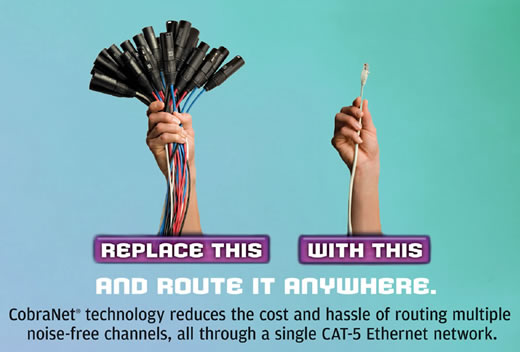- Connecting audio
- Audio PC
- Raspberry & Co
- All in Ones
- Bluetooth
- Chromecast
- Streaming audio player
- Music server
- USB Audio
- Real-time audio over IP
- FireWire DAC
- Multi-channel DAC
- NAS
- Remote control
- Vinyl rippers
- Acoustic materials
- Active crossover
- Active speakers
- Single driver speakers
- Invisible speakers
- Sound card
- Digital room correction
- Headphone
- Portable media players
Real-time audio over IP
Streaming audio over IP has become common.
The first decennium of this century protocols like UPnP/DLNA emerged and has become mature over time.
This is how most streaming audio works today. A DLNA enabled control point browses a server for content. The content is pulled from the server by a renderer (playback device) .
It is more or less comparable with the way web browsers and web servers work.
DLNA is developed with networking in mind.
First it buffers a substantial amount of data before playbacks starts.
In the studio the requirements are quite different.
No need to browse a server for content.
You have multiple audio streams e.g. 10 mics and all these streams must be in sync. The feedback to the monitors of the musicians must have a very low latency otherwise they will mistime.
You can do real-time streaming over IP with a very low latency.
This requires dedicated protocols like AVB, Cobranet, Dante, Ethersound, Ravenna and AES67. The latter tries to unify all those different protocols.
It is very attractive to use IP technology in a studio. You can use of the shelf IT-products like switches and CAT5 cables cutting cost substantially.

This add by Cirrus Logic says it all. Cost reduction and flexibility.
Consumer
At the home, we in general do not have tons of gear, bundles of cables, do not record and are not in need of a very low latency.
There are cases where synchronization is important:
- Home theatre: as audio and video often travels different path, lip sync is important.
- Multi room audio or 2 channel audio over the LAN: speakers must be in sync, our ears are pretty sensitive to small differences in phase.
Protocols like USB, Toslink, SPDIF put constrains on the length of the cable.
Of course this applies to Ethernet as well but a 100 m is covered without a problem by a CAT5e cable.
An option is to use one of these professional protocols to connect a PC to a DAC like we do with USB but this time over the network.
You need a virtual sound card on your PC.
It presents itself as an audio device to the media player and send the audio over the network to a DAC.
This is a more flexible solution than USB simply because we are not tied to the 5m USB limit.
We can place all computers outside the listening room if needed and control them remotely.
Likewise all the power of the media player on the PC is at our disposal.
Be it the interface of the DSP like convolution (room correction), the PC is in general a far more versatile platform than the average streamer.
We are pretty much in control doing so.
Basically it is like using a USB DAC without the constrains of USB.

